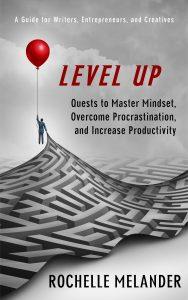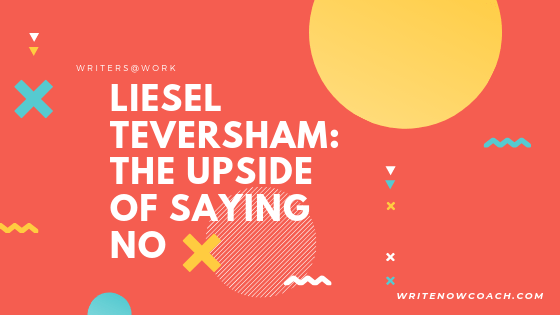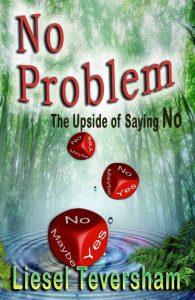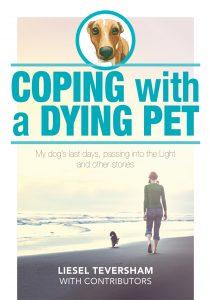The Upside of Saying No with Liesel Teversham
September 24, 2019
Note From Rochelle
Dear Writers,
 During the week of October 14-20, I will be celebrating my new book with several fun promotions. One of them is a class: Gameify Your Writing Life. In this class, you will learn why games are an effective tool for self-improvement and how you can use game technology to rock your writing life. Attend the class live at no charge or purchase the recording later. Sign up on my workshops page.
During the week of October 14-20, I will be celebrating my new book with several fun promotions. One of them is a class: Gameify Your Writing Life. In this class, you will learn why games are an effective tool for self-improvement and how you can use game technology to rock your writing life. Attend the class live at no charge or purchase the recording later. Sign up on my workshops page.
Today, I am delighted to welcome my colleague Liesel Teversham to talk about her book, No Problem – The Upside of Saying No, blogging a book, and the benefit of using EFT for writing.
Enjoy!
Rochelle

Writers@Work: An Interview with Liesel Teversham
By Rochelle Melander
 Welcome, Liesel! It’s wonderful to have you at the blog. Can you tell us a bit about your book, No Problem – The Upside of Saying No.
Welcome, Liesel! It’s wonderful to have you at the blog. Can you tell us a bit about your book, No Problem – The Upside of Saying No.
It’s a book for anyone who is exhausted and never has time for themselves…. for those who have no idea how to say no because it’s just too uncomfortable to disappoint others.
What led you to write this book?
It was born from my own very long struggle with taking on too many responsibilities, saying yes to every request, and ending up with way too much on the plate. Exhaustion, resentment and guilt were my constant companions!
The longer background story:
I’d had a desire to write a book for most of my life. At age 42 it got so strong that I even had a series of coaching sessions to help me start writing…. But it was a struggle! The biggest challenge I faced was WHAT to write about. It seemed so daunting and I didn’t yet see myself as an author.
At last I landed on a topic and I thought I’d just write a quick little e-book about “Overwhelm and saying yes to everything.” As I started writing, I realised how much there was underneath the pattern to over-do and over-give, and ignore my own needs.
The topics took shape as I was writing, and I realised this could be a “proper book.” I completed it in 18 months and of course it includes one of my favourite tools to manage stress: EFT. I included the Enneagram numbers who are most likely to find it hard to say no, the 6 core human needs, some missing childhood messages that cause us to say “yes” more than we should, and co-dependence.
I had to battle many inner insecurities on the way to completion. The biggest challenge was that I kept putting off my writing because again, I “said yes” to helping others, instead of writing. Fertile ground to write from personal experience!
I am really interested in EFT and how it helps people. Can you talk a bit about what EFT is and how it can help people feel better?
Oh, my favourite tool! EFT is short for Emotional Freedom Techniques, and our readers also might know it as “tapping.”
It’s a beautiful self-help method that we can use to help calm our fears, concerns, worries, anxieties…. All those emotions that can form road blocks to our desires. EFT offers a way to send calming signals to the amygdala (from where the fight/flight/freeze response originates), so that we can feel relaxed, think more clearly and take appropriate action.
It’s so simple to learn that even kids can use it. Many peer-review studies have been conducted, and the research shows that it can be more effective and long-lasting than Cognitive Behavioral Therapy (CBT).
A simple example where it would be effective:
Say I’m procrastinating on writing a blog. Or, I have a dream to write a book but I can’t get myself to start.
One of the main reasons for procrastination is we’re afraid of a negative outcome. We fear rejection, criticism, public humiliation, ridicule and painful emotions like abandonment and exclusion.
EFT can help us very effectively to calm those fears and concerns. We focus on telling the truth about it (“Even though I am terrified of rejection”), add a statement of acceptance (“I can love and accept myself anyway”) while also lightly tapping on stress-relief points on the body.
This mind-body technique is soothing and can quickly relax our fear-brain, so that we can start writing (and wonder what the big deal was).
I recommend that writers with these fears do a few rounds of EFT before they put pen to paper.
With 2 fingers of one hand, tap on the side of the other hand while saying
“Even though I’m terrified that they will reject my work, I love and accept myself anyway.”
 Then, on each stress-relief point [shown on image at left], tap about 7 times with 2 fingers, repeating a reminder phrase like “afraid of rejection”.
Then, on each stress-relief point [shown on image at left], tap about 7 times with 2 fingers, repeating a reminder phrase like “afraid of rejection”.
Measure your fear before the round (using a simple scale of 0-10) and measure again after a few rounds. If you’re not making progress, contact a professional to help you get past that. It may be something simple you’re overlooking. While there are many “tapping scripts” to be found on the internet, it’s best to use the words you would personally use to describe how you feel. EFT works best when you tune into, and tell the truth in your own words.
People who want to write need to be able to say no in order to carve out time to create. What are some of your tips to help us set boundaries, set aside time to work on our art, and take care of ourselves?
This made me grin because it’s exactly what was in the way for me when I was writing my first book. I kept giving away my scheduled writing time to EFT clients whom I thought needed a session more than I needed my writing time!
A few tips I learned during my own trials and tribulations:
+Be very clear on the “why” for your writing. How will it benefit yourself and others when your writing project is complete? This is a great way to stay on track. Put your “why” somewhere visible and read it daily.
+Become aware of HOW you give away your writing time. I learned that I could virtually teach someone else how to do that: A client phones, I check my diary, I see a writing slot, I think “They need it more than I do”, I give that time slot to the client. I did the same thing over and over and needed to interrupt my usual thoughts. I had to replace my thinking with “They are resourceful, creative human beings who survived thus far, and they can survive another few days.”
+Have you scheduled time in your calendar and gently informed your house mates, partners, children and others who depend on you? Or are you expecting yourself to stumble upon little writing gaps here and there? It’s likely not going to happen.
+Start trusting that people are more resourceful than you think. If we do everything for another, we take away some of their own problem solving growth opportunities.
+Use EFT for any guilt, concern, worry or fear about not being available for others during your writing time. We make decisions from emotion, not logic and reason. The benefits will ripple out to other life areas as well.
I know that you blogged part of another book. Can you talk about how that practice helped you to get the book done?

My second book Coping with A Dying Pet came to life after our sweet Jack Russell crossed over the rainbow bridge.
I blogged about the trying journey of coping with a very sick dog. Every time a difficult situation arose, I wrote a blog post and started gathering a following of animal lovers who loved the stories. A few days after he passed away, I knew I had to write about his final few days to help me process it.
Even though I used EFT throughout the difficult journey, writing is a very healing activity for me. About a week after his passing, I knew it was time. I wrote the rest of his story within a few days while the awfully painful details were fresh in my mind. I cried many tears in the process, yet felt his presence next to my chair. It brought so much healing of the grief.
The idea was born only then: Oh! I could use all my previous blogs and combine it with those last few days to compile a book.
I wanted it to be as helpful as possible for those going through a similar hard journey with a sick pet, and therefore added collaborators.
I had used animal communicators over the months of his illness to help me make hard decisions. I asked them to contribute their wisdom to the book. The vet who treated Jack for many years, wrote the foreword and checked the medical facts. I loved the teamwork with other animal lovers.
What are you reading now?
You mean the big pile next to my bed? I always seem to be reading a few books at a time. I love both fiction and non-fiction. I use fiction to switch off my overactive brain. Since we’ve moved to the UK from SA, I’ve discovered fantastic British fiction writers.
Current fiction:
The Rest of Me by Katie Marsh,
This Beautiful Life by Katie Marsh
Current non-fiction:
The Brain that Changes Itself by Norman Doidge
Tuning the Human Biofield by Eileen McKusick
Meta Messages from your Body by Sam Thorpe
Thank you Rochelle, for your wonderful questions!
About the Author
 Liesel Teversham helps introverts and sensitive souls to build beautiful confidence, embrace their strengths, love their work and practice awesome self-care so they can be energized and make a difference in a meaningful and fulfilling way. She helps them to overcome the fear of being visible, avoiding the spotlight and conflict, being ‘too nice’, perfectionism and procrastination.
Liesel Teversham helps introverts and sensitive souls to build beautiful confidence, embrace their strengths, love their work and practice awesome self-care so they can be energized and make a difference in a meaningful and fulfilling way. She helps them to overcome the fear of being visible, avoiding the spotlight and conflict, being ‘too nice’, perfectionism and procrastination.
She’s the author of No Problem. The Upside of Saying No, which is a handbook for those who struggle to say no, are overwhelmed and exhausted.
Visit her blog at www.savvyselfgrowth.com
FB Page: https://www.facebook.com/SavvySelfGrowthforIntroverts/
LinkedIn: https://linkedin.com/in/lieselteversham/








